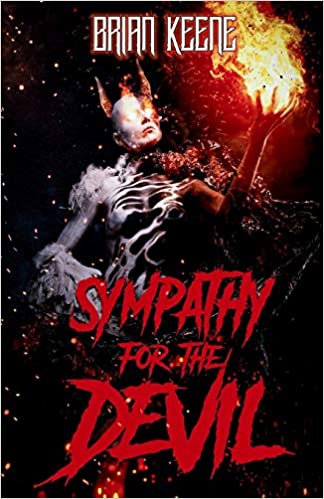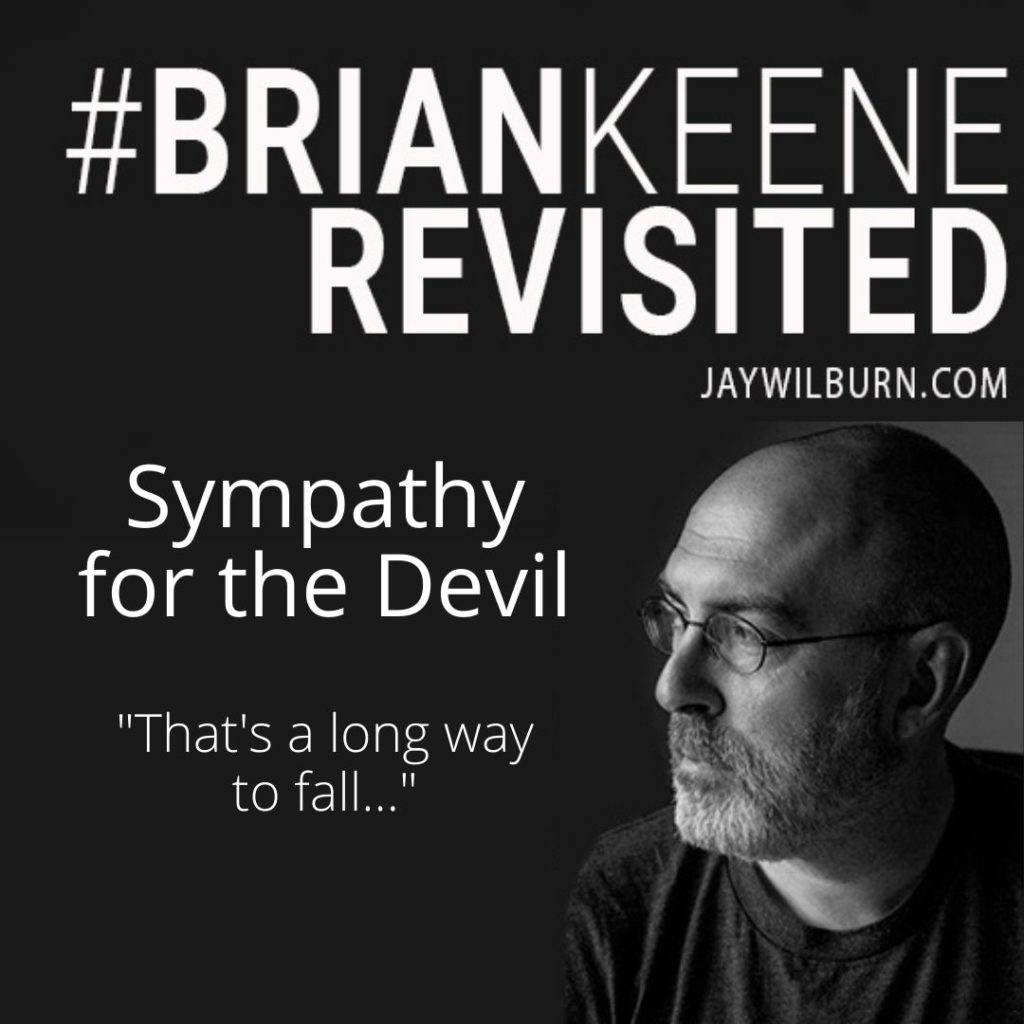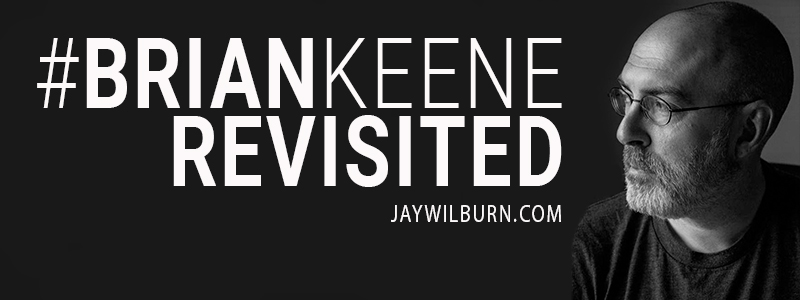The plan is to reread all of Brian Keene’s available works in roughly the order that they were published. I’m doing it because I’m an author in need of improvement and a reader who enjoys a storyteller willing to bleed out on the page in a powerful and interesting way. I’m a fan of Keene’s work. I think there is something to be learned through this process.
You can also go back to the Introductory Post: A Gathering of Books to read more about the how and the why of this or any of my other posts up through this one and beyond by checking out the Master List of all my #BrianKeeneRevisited posts.

Get ready for some classic Brian Keene rants because we are tackling Sympathy for the Devil: The Best of Hail Saten vol 1.
I don’t even scrape the surface of what most of the table of contents of this work holds. You’re going to have to buy it and read it to really appreciate what it has to offer.
I’m a huge fan of Brian Keene’s nonfiction writing. A number of those essays have played a role in big career shifts and professional choices for me. I wasn’t aware of nor connected to his early stuff preceding and immediately following The Rising. I missed out on his pioneering Internet presence in those days. Most of these pieces were brand new to me as I expected.
He warns in the lead-in to these old writings that many pieces and opinions are outdated, but he fought the urge to edit them. I’m shocked he let all of this stuff fly. While he was ahead of his time in many insights, there are bits here and there that I imagine had to make him cringe to revisit. I wouldn’t have had the guts to leave all my flaws and foibles of the past on display in their raw form the way he did. I don’t have that kind of courage. Even at points where he is dead right and ahead of the societal curve, he’d still slip into moments or phrasings that his older self would never say today. You should read this stuff just for the guts it took to put it back out without edits or strategic omissions.
This was an earlier version of Brian Keene than the one I know, the person and the ideas he evolved into. Beyond changes in viewpoint between then and now, I had a tough time pinpointing what exactly was dramatically different about him. This early version of Keene seemed more brash, but unless I’m only counting some very recent changes, he is still purposely brash from time to time in recent history. Especially among people on the receiving end of his ire, I imagine they see nothing but a brash Keene past, present, and future. So, that isn’t it. This early Keene sunk into a few wild rants, but it’s not like current Keene is entirely rant-free. In sections of this work, his claims and exaggerations of events are a little over-the-top and not completely grounded in a realistic recounting of what probably really transpired. Though, it is not like Keene doesn’t dabble in hyperbole to enhance a story for entertainment value now. Maybe he’s a little more skilled at weaving fiction into his nonfiction work now. There is a core to him including the good and the bad that has stayed constant as more subtle growth has occurred around the edges. Maybe subtle isn’t a word you normally hear used in describing Brian Keene, but I think it is true. There is some subtlety to his evolution over the last couple decades that I think has been mostly overlooked by many with all the bombastic elements of his author persona. I do think he is a better person now. He suffered in earlier decades too, so it is not purely the impact of experience or hardship that accounts for the wisdom and discernment he may have added since his youth. His family relationships certainly changed multiple times between then and now. There are hints of humility and self-deprecation in these early writings that sneak through the front of bold indestructability. Maybe he reveals a bit more vulnerability now than he did in the past. This early Keene is different, but how and to what degree exactly, I’m not able to say with any real confidence or authority.
These early years are playful, tongue-in-cheek, and just over-the-top enough to clue in those who are in the know that he’s having fun with the rest of the world, industry, etc. You either got it or you didn’t. Most of the people who subscribed to the site did get it. Most of them anyway…

This new edition of Sympathy for the Devil is dedicated to Wesley Southard, Kit Powers, and still Bob Ford, like the previous time. Southard and Powers nagged Keene into rereleasing it apparently. Good for them.
I’m a little jarred by how haunted these pages are. Dead people and long ago disintegrated publishers litter these stories. They are up, walking around, and vital in this book like they are not really ghosts at all. Is 20 years that long? Does 2000 not feel like yesterday if you ignore for a little while how much has changed in over two decades’ time?
We get the origins behind Hail Saten. We learn how he got his scrotum torn in an industrial accident. That bit finds its way into the novel Terminal, as I recall. We see the birth of the Horrorfind convention. I didn’t realize how long he was involved in helping organize conventions. We see Mary SanGiovanni with her then boyfriend “Not Brian.” “Not Brian” should have known his days were numbered when Keene reached out to comfort her in that elevator. You blew it, “Not Brian”! We also get the first time Keene met Bob Ford.
The HWA (Horror Writers Association) is hit early and hard in this book. I liked his takedowns of the HWA over the years because I wasn’t a fan for a number of reasons of my own. There have been some marked improvements in recent years. These essays demonstrate that positive changes can be undone quickly though. Such a great series of falls. Keene has come back around on the organization too, I believe, to my dismay. Like getting back with an ex or giving that spoiled milk another chance, Keene sometimes gets along with some “exes” too well. “I think they’ve really changed this time.” Maybe I need to be more gracious.
“Horror has more assholes per square inch than any other genre.” Other genres are starting to catch up in recent years, but I think this sentiment may still broadly hold true.
A recount of the 2000 World Horror Convention through the eyes of a younger Brian Keene was like finding an ancient tablet covered front and back with forgotten history, but as you are translating it, you discover too late that it was laced with LSD. Now, we’re tripping with Keene into other worlds and times.
At the 2000 World Horror Convention, Keene made a few sales at the group signing and then concluded that “getting paid in copies paid off.” Get the fuck outta here, Younger Keene, before I send Older Keene to whip your ass! The Stoker Awards were too expensive for him to get a ticket on his own then. Someone hooked him up and he found himself in a whirlwind as a new writer on the scene. Charles L. Grant’s speech at that event echoes some of Keene’s later life philosophies. The book is worth the price just for the full account of Keene’s experiences at that convention and others.
We see Keene dealing with and lashing out about the death of Richard Laymon. The whole time Laymon was on the page in the earlier essays and posts I felt this dark cloud of dramatic irony where I knew what was coming, but none of these young folks Laymon was so kind to had any idea this loss was imminent.
His life has been plagued by computer problems then and now. Keene listing off the specs of the computer he bought with The Rising’s movie option money is the most outdated portion of the book by far. His high hopes for The Fantastic Four movie because “Vic Mackey was going to play The Thing” may be a close second.
Keene has never had a good system for answering emails or dealing with incoming communications. Over two decades is clearly not enough for him to get a handle on that. He also had a compulsion to engage these communications that began way back in the analog transition days when he simple could not stop from answering a ringing landline. Once answered, he could not stop himself from fucking with telemarketers either.
He probably listened to a little too much Howard Stern back then, but I will say Keene gleaned the best lessons of interviewing style from Stern, left the rest, and made it his own.
Keene has claimed to “retire” from things quite often for much of his career. He claimed to retire from rants at one point. Get the fuck outta here, Mid 30s Brian Keene! I’ve had enough of your shit, young man. People have had easier times quitting organized crime.
He became a full-time writer, sold his newsletter to Kelly Laymon, and planned to become a recluse like Bently Little. Oh, Silly Optimistic Younger Dreamer Brian Keene. Even you must have seen the futility of this plan.
He wasn’t too young by 2003 and 2004 to have a little “kids these days” and “get off my damn lawn” slip into his rants. Very early on he went from feeling like a young turk taking part in the revolution to lift horror into new heights to feeling like those coming up behind him were destroying the gift he had given them.
He was talking about feeling old at 35. Oh, Summer Child Brian Keene, wait until you see the bullshit Mid to Late 50s Brian Keene is going to put you through! I think living through “Keene Years” is kind of like dog years but with more fire and fistfights. I love Brian Keene, but it is a wonder the dude has managed to stay alive this long.
Some of his rants are near timeless while in other cases he’s going on about the Lacy Peterson case, the Terror Threat Level Color Code Chart, or Janet Jackson’s nipple and the FCC. There are universal lessons to be drawn from all of this, but the examples are firmly tied to their time periods.
People got to see his breakdowns live. He was out there and public very early as part of his Internet brand. He was fighting people online and repeatedly before Facebook or Twitter made that sort of stuff easy. Others had to wait for social media to grow before they were nearly as exposed as him. The Public Brian Keene of the new young writers cabal and of “gangsta horror” was cocky before his time, which may be a big part of how he achieved what he did at all. I’m a firm believer in the power of believing your own myth before anyone else does.
There was a lot of threatening to shoot people, mostly in the face, and not just when he was trying to quit tobacco.
Brian Keene wasn’t a huge fan of self-publishing in the early days. The conditions on the ground were a bit different then before Amazon became everything it was going to be.
The Rising’s book tour was a wild ride. I’m not saying Keene is always an unreliable narrator, but at one point during the tour the sun rose over the Pacific while he was in California. Beware if you are ever touring with Brian Keene. The universe does not behave the same when he’s around.
At one point, he claimed to have found the final draft version of himself. What?! Really? Come on, Mid to Late 30s Brian Keene.
In this portion of his life, he goes to the cabin to knock out some of those early works that followed The Rising. He returned to that cabin, I assume it is the same one, in 2021 as he tried to knock out several more backed up projects in recent days. In this most recent visit, he found the years and the hard-knuckled suffering of those years had caught up with him and demanded more breaks than the young version of him required.
When the Devil looked over the edge, he said, “That’s a long way to fall.” You hit that right on the nose, Wise Young Brian Keene. My God, a lot changed over these years and Brian Keene bore witness to it all.
My next post in this series will be Terminal #BrianKeeneRevisited which can be found on the Master List of all my #BrianKeeneRevisited posts. Note: The photo of Brian Keene used in the banner image of these blog posts was taken by John Urbancik and used by permission of both Keene and Urbancik.






I absolutely loved reading this book again after over a decade since my last reading of it. I’ve always been a huge fan of Brian’s non-fiction and his rants and boy oh boy does this one deliver on that. I have all of the old Delirium Hail Saten collections and this is the book that introduced me to Richard Laymon’s work. After finishing it the first time, I immediately went to a Hastings and bought a Leisure paperback copy of The Cellar and enjoyed it thoroughly. It was also really sad with Brian recounting Laymon’s passing. I knew they were super close and that Laymon was a big part of Brian’s early success.
Reading this book was indeed a travel back in time to the early days of the Internet when I used to find chat rooms and message boards to discuss my love of Stephen King and Dean Koontz. I found it hilarious in the chapter about when he was on The Rising book tour and he was trying to sell copies of his book to random people and nearly all of them said they liked King and Koontz. That was me! It wasn’t until I stated reading Brian that my knowledge of the horror genre expanded immensely.
I also loved hearing about the many entries about the conventions that he attended. I got the chance to meet Brian at VisionCon 2009 in Springfield MO and again in 2010. That second time I actually got to hang out with him when he offered to buy me a drink at the hotel bar after I spotted him there and nervously went up to him and asked him if he remembered me from the previous year and he did. I ended up going room to room with him to different parties finding drinks, getting drunk, and then attending the dance that night with a drunken and hilarious Cullen Bunn dancing away like crazy. That was the most fun I have ever had at a convention. Brian is truly one of the nicest guys ever and he never forgets where he came from and he doesn’t take what he’s got today for granted. I admire the hell out of that.
I also really loved hearing about what was going on in his life around the time he was writing The Rising, Terminal, and City of the Dead. I love hearing about his writing routine and his battles with the distractions that stop him from writing. I love his rants on things like the Iraq War and Jack Black supposedly being cast to play Green Lantern?? Sure don’t remember that happening. Thank god it never happened. I can’t wait till the next non-fiction collection. In the meantime, I just received my brand new copy of the Author’s Preferred Edition of Terminal just in time for my reread of it. It’s maybe my favorite book of his ever, so I’m curious to see how it measures up to the original. Really enjoying this journey through Brian’s work. I hope I can keep up!
Oh, that’s awesome. I didn’t meet him until much later. As many of his books as I’ve read, most of these will be new to me. Terminal was a first read for me this time. After reading the original, I want to check out the author preferred edition.
He was definitely channeling his inner Hunter Thompson on some of these. Other times, there was brutal, raw emotion from someone still young and discovering the ins and outs of the business, friendships, and relationships. A rare few have some phrasings which are a bit cringeworthy, but we know that he is aware of that and has changed since. And that’s what is important—that we all learn and change for the better.
Like I said, I wouldn’t have had the guts to leave it all out there. Across the board, it holds up pretty well though, especially as an archive of a very specific time. There is not a damn thing I wrote or said from that era that would hold up if I found it again.